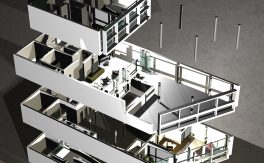In Summer 2011, Liam graduated from Westminster with First-Class Honours in Architecture, having been awarded with a scholarship for academic excellence.
During the course he worked on a wide variety of projects; from the 3D jigsaw of designing dense urban neighbourhoods to the environmentally conscious challenge of building on a wind-swept sea-front. A common theme running throughout 3 years of design work is that of transitions and sensory experiences; and thus the human behaviour which forms a basis for that too.
Thinking of buildings in terms of spaces rather than containers, and placing a new significance on the thresholds between them, has led him to an enriched understanding of the built environment in which we all live.
It almost sounds cliché, but it's true that I've always been interested in architecture since I was just a kid. Whilst others were playing on the latest games consoles, I drew. I drew hundreds of designs that, whilst obviously childlike, were clear signs that this subject would go on to fascinate me for the rest of my life.
I remember drawing a plan of a water park. It had every type of aquatic attraction thinkable in the end; I started with one A3 page and gradually extended it and extended it until it became 10 and then 20 A3 pages all stuck together. That excitement – of designing for thrill – continued, and as I grew older I started designing full theme park concepts from ride storylines right through to 20 year strategic development plans; a few of which can be seen in the portfolio.
I studied art at school, and I loved it, despite the time it ruthlessly stole from the rest of my life. I was always one of the best artists there, but it wasn't art for the sake of art that really interested me; it was design that can affect people's way of life. Design that can evoke emotion, motivate us, inspire people, and change perception. And that's why I love architecture – and why it pains me that so must of the industry is so mediocre. It has the subliminal power to change lives, and yet its true significance is rarely appreciated... Somehow, someway, I will change that someday.








